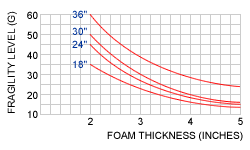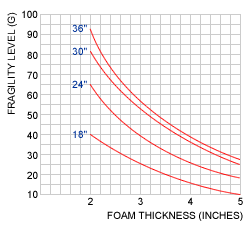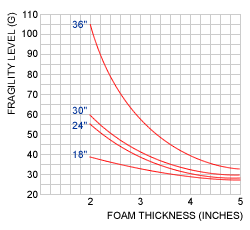Foam Selection Guide
Follow these easy steps:
- Determine the “fragility” level of your product-using
Chart 1 as a guideline.
- Determine your product's static loading on the foam (psi). Do this
by dividing your products gross weight by the largest surface area
that will rest on the foam (square inches).
Example: If your product weighs 10 lbs. and the
largest surface area which will rest on the foam insert is 25 in.2,
the static loading will be 0.4 p.s.i. (10/25 = .04)
- Match your answer to Chart 2.
- Find your foam on Chart 3. Enter at your products fragility level,
move horizontally to intersect the drop height curve. Then move vertically
from the point of intersection to determine the required foam thickness.
| Chart 1: Approximate Fragility
of Typical Packaged Articles |
| Extremely Fragile |
Missile guidance systems, precision aligned
test instruments |
15-25 g’s |
| Very Delicate |
Mechanically shock-mounted instruments and electronic
equipment (Shock mounts should be firmly secure prior to packaging.
They are provided for in-service protection only.) |
25-40 g’s |
| Delicate |
Aircraft accessories, electric typewriters,
cash registers and other electronically operated office equipment |
40-60 g’s |
| Moderately Delicate |
Television receivers, aircraft accessories |
60-85 g’s |
| Moderately Rugged |
Laundry equipment, refirgerators, appliances |
85-115 g’s |
| Rugged |
Machinery |
115 g’s and up |
Chart 2: Foam Selection
| Static Loading |
Recommended Foam |
| 0.1 to 3.5 |
2# polyurethane |
| 3.5 to 6.0 |
4# polyurethane |
| 0.6 to 1.2 |
2# polyethylene |
Chart 3: Foam Thickness
 |
| 2 pound/foot3 polyurethane |
| |
 |
| 4 pound/foot3 polyurethane |
| |
 |
| 2 pound/foot3 polyethylene |
|
